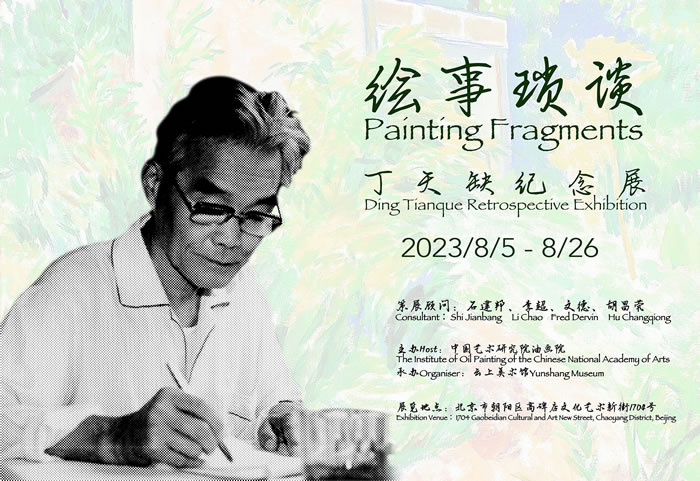
展览海报
展览名称:“ 绘事琐谈”丁天缺纪念展
策展顾问:石建邦、李超、文德、胡昌茕
文献整理:丁韵秋
开幕时间:2023年8月5日周六下午三点开幕(需要邀请函入场)
主办单位:中国艺术研究院油画院
承办单位:云上美术馆 (北京市朝阳区高碑店文化艺术新街1704号)
协办单位:ICI LABAS 艺栈 、CCIFC中国法国商会、Capella Cultural Program 嘉佩乐文化计划、AFAP法国造型艺术家协会、WM ARCHITECTS法国米多建筑设计师事务所
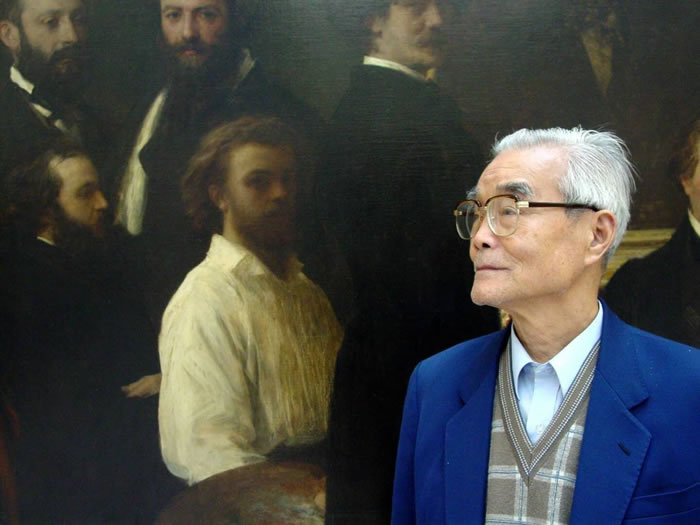
丁天缺先生照片
为天缺公而歌
——丁天缺纪念展序言
李超
20世纪的中国美术历史长河,不乏艺术群体的星光闪耀。发端于西湖之畔的国立艺专的第二代,正是这样具有核心作用的代表性的艺术群体。谓其核心,在于中国的现代美术教育学术主体力量,赋予历史转型以中国之魂和东方之韵。以师生传承作为学术基点的第二代,随同其师,亲历并参与了历史的转型,见证了学院“调和中西艺术,创造时代艺术”的学术影响力。这种“为艺术战”精神气质,犹如血脉胎印,注定他们将学术抱负与艺术责任,与中国民族艺术的振兴命运相连,这种学院品格赋予了第二代独特的艺术生命力,这是他们奉献于20世纪中国美术可歌可泣的精神礼赞。
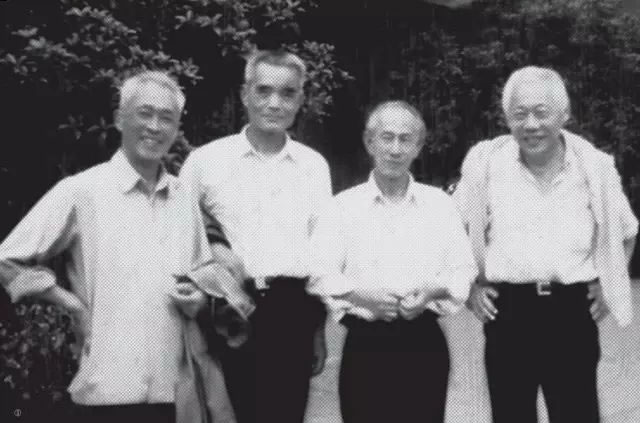
丁天缺(左二)与吴季鑫、庄华岳、赵无极
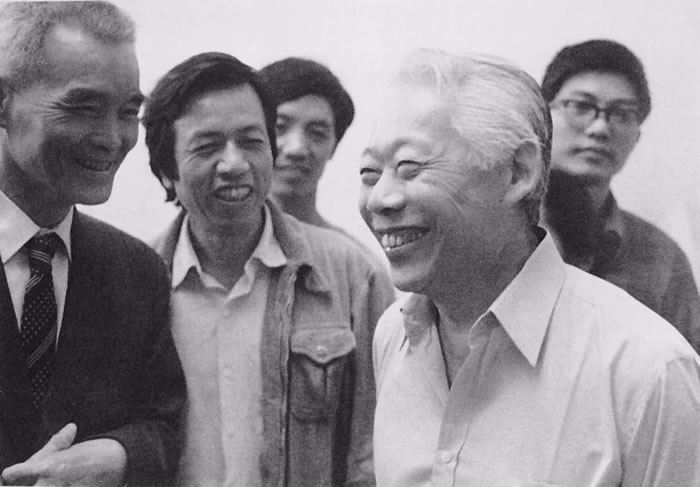
1985年春赵无极回杭州母校举办油画讲学班时合影 左起丁天缺、尚扬、孙建平、赵无极、许江
然而,对于国立艺专第二代的认知,实质上是“迟到”的发现。其中初始的引发点,是20世纪80年代本土现代艺术历史的关注。包括赵无极、朱德群等在内的海外军团。随之对应着那段风雨兼程的文脉历史,逐渐再度认知他们的师长林风眠、吴大羽、蔡威廉、方干民等诸多先贤的作为;也逐渐还原着吴冠中、闵希文、张功慤、丁天缺等诸多弟子的史实,他们含带各自的历史遮蔽,进入我们后学研究的视野。在还原与认知的过程中,我们不禁感佩他们在人生的磨难中不息保存艺术意志的坚韧,感佩他们与世界对话的艺术语言的前沿实验特质。其中丁天缺不失为一种特殊的呈现。——不管历史存有多少曲折与磨难,只要存有觉醒者所谓“怀有同样洁愿的人,无别离”的心智,就有高度和光芒的格局,就有再生和共享的未来。

杭州美院校庆70周年合影
丁天缺的艺术人生,是一段泪水与星光交织一体的“传奇”;更是历练自强而历久弥新的中国现代美术的“华彩”。而作为第二代的丁公的同窗学友,他们是相映成辉的命运共同体。如今皆为美术史研究中的一线名家,他们何以共同进入历史研究“胜利者的清单”,难道不正是这样高度与光芒吗?

1984年,丁天缺与林文铮、赵无极、张功慤、胡善馀等
随着行文的行进,思绪中涌现出30年来,陆续与第二代前辈交往的经历,对于国立艺专第二代的认识,从书本转为现场。90年代初为撰写《上海油画史》而专程拜访闵希文先生。1996年赴京,专程为吴大羽先生举行的学术研讨会发言学习。当时吴冠中、张功慤等第二代出席此会。他们为第一代的吴大羽而来,却道出了令人感动的第二代的情缘。四年前,我有幸见到第二代的最长寿的见证者张功慤先生。倘若吴大羽是一颗不可忘却的“星”,那么教学相长的相关师生,已经合成为独具光彩的“群星”。由此于三年前,完成了“看不见”的国立艺专第二代的初稿写作。
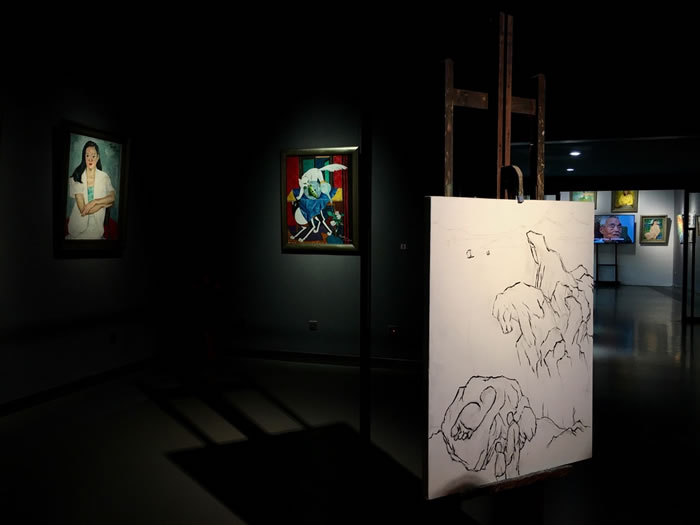
2018年丁天缺个展,丁老生前所用画架与未完成的画
此稿再修订,自然来自今年丁韵秋老师以及她的朋友圈的支持与鼓励。在我接触到的三百多位中国油画名辈家属中,不乏拥有特别人文情怀者,丁天缺的侄女丁韵秋女士,即是其中生动可敬的一位。通过她之前组织和努力,加之朋友圈的齐心协力,2021年成为丁天缺的“苏醒”时间。——2021年3月13日,丁天缺回顾展在京开幕,这不仅是艺栈画廊的2021年首展,也是2018年末《梦里孤山——丁天缺艺术人生》由中国美术学院出版社出版,学界见得丁天缺遗著一书问世后在北京的一次重要呈现。2021年10月在杭州国立艺专旧址,西泠书画院举办《丁天缺诗词集》首发式暨学术茶聚。2021年年底。艺栈画廊迎来了年末压轴大展:丁天缺诗画展。此次展览是继“丁天缺诗词集”首发活动后,移至北京的再度亮相。通过对丁天缺先生的诗词手稿及绘画原作、版画的展示,向观众呈现其更加生动的创作成果。
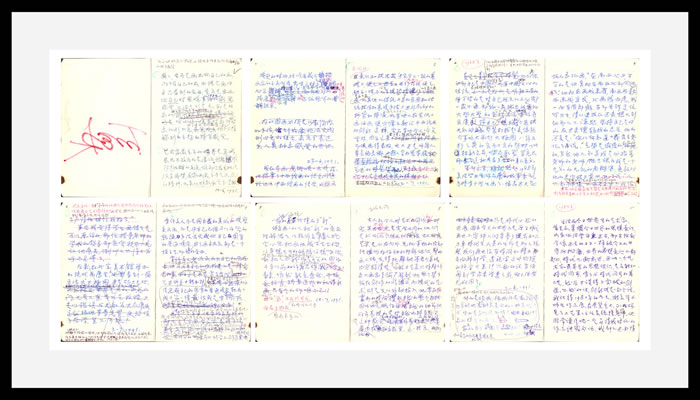
丁天缺部分日记手稿

丁天缺部分著作
跨越疫情困顿之期,2023年6月,我与团队在北京拜访丁韵秋老师,她又向我们呈现了她与家人共同整理与翻译的成果,《艺舟夜楫——绘事琐谈》,英文译本(with original Chinese script),这成为了丁老师与她的友人,在今年策划相关丁天缺艺术巡展的一个重要学术焦点。——2023年,孕育着为丁天缺“再生”而行动的高光时刻。
《梦里孤山》、《丁天缺诗词集》与“绘事琐谈”手稿,是丁老留给我们后学的学术遗产,是这位艺术先贤留给世界的珍贵艺术之物与历史之物,可以视作为国立艺专第二代的学术结晶,馈赠于画界与学林。今时,在国立艺专第二代渐行渐远于天国的同时,先贤的诸多精彩的话语与概念,凝聚其艺术创作与思想,化作历史的回响,令我们深味不已。在古今之间,在中西之间,作为艺术家的文化融合使然,丁老的相关的笔记,字语真切,呈现了视野的宽度和思考的深度。这是第二代先贤们艺术思想的又一次折光。

值得关注的是,第二代的艺术虽然各自发展有别,但是学院派的基因与影响,构成了他们艺术创作中的某些共性的呼应关系。比如时空结构的概括性、心灵世界的抒情性、中国意象的书写性。不过在第二代的艺术家之中,他们各自形成自己的艺术探索的风格化路径。从目前所见的丁天缺的40年代作品图像而言,对于形式表现的敏感与创造,已经呈现在早年的艺术实践之中,中后期跨越80至90年代,难能可贵地呈现艺术复苏的生命力,所作静物、肖像和景物,已经赋予多种变体与重构的探索迹象,相关艺术创作在空间构成、色彩表现与图像寓意等方面,体现传统守正与语言创新的互通与协调。再一次验证艺术创作中“新”的辩证理解与贯通。在传统深处提取创新探索的新元素,在国际对话的语境中彰显现代艺术的“中国时态”,——由此赋予丁天缺艺术的学术品格。其画风求新独到,个性率真而别开生面,又与第二代的创作面貌相得益彰,成为20世纪中国现代绘画时代标程的生动缩影。

1990 花Flower 61×46cm
文化传承有如生命纽带,牵连着两代艺术家“为艺术而战”的艺术历程。这两代艺术家群体的研究,其价值意义,已经不限于相关的校史研究的范畴,而逐渐移入中国现代美术历史研究,乃至中国近现代美术国际交流的专题领域。2023年的丁天缺纪念展,无疑形成了可观的学术拓展。而其中一个潜在的学术诉求,即为“丁天缺与他的时代”。这样的学术定位,赋予了丁天缺与第二代艺术资源的共生与兼容,构建了从本土出发,向世界述说中国故事的叙事语境。

1980窗前偶见80x73cm
与展览的策划团队相约同行,我们有所感悟的是,一个闪光的点,带动着华彩的线。由丁公天缺先贤引至国立艺专第二代先贤们,这样的艺术群体进入艺术史的研究对象,其相关的历史之物与艺术之物的复合,是研究得到持续而深入的重要关键。在这里,一代与二代皆有被遮蔽与碎片之残存境遇,相关艺术遗产的存世量或多或少,相关艺术文献著录率或重或稀,我们也十分愿意通过自己的学术积累与数据库的加持,体现近现代美术研究成果学术赋能的作用。由此可见,此次纪念展的巡展历程,将是一个学术与合作、互动、共享的社会美育的生动范例。经历20世纪80年代至今,国立艺专艺术家逐渐涌现,迄今形成中国近现代艺术史研究视野中,不可或缺的重要艺术群体。几乎每一个生动的个体,都牵动着这一艺术群体珍贵的文化资源。今天,丁天缺纪念展再次显现应有的学术之光。
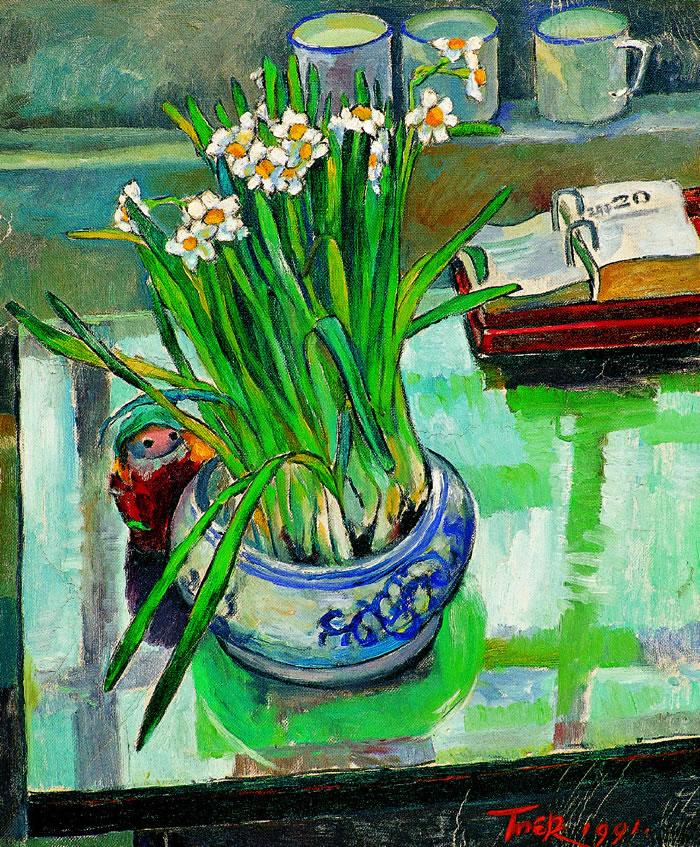
1991岁朝58x48cm
为天缺公而歌,——是为国美二代“无别离”而念的初衷;是对丁天缺艺术资源“再生”的期待;更是为优化中国近现代艺术史研究学术生态的献力。
2023年7月于千蕖堂
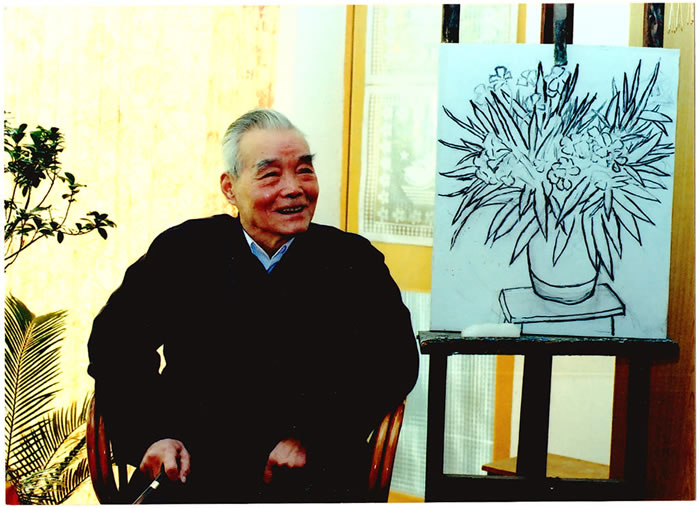
丁先生坐在画前
Ding Tianque Retrospective Exhibition“Painting Fragments”2023/8/5 - 8/26
Consultant:Shi Jianbang Li Chao Fred Dervin Hu Changqiong
Documents arrange:Ding Yunqiu
Opening: Saturday 05/08/2023 at 3:00 p.m.
Host:The Institute of Oil Painting of the Chinese National Academy of Arts
Organiser:Yunshang Museum(Gaobeidian Cultural and Art New Street, Chaoyang District, Beijing)
Co-Organizer:ICI LABAS 艺栈 、CCIFC中国法国商会、Capella Cultural Program 嘉佩乐文化计划、AFAP法国造型艺术家协会、WM ARCHITECTS法国米多建筑设计师事务所
Praise for Ding Tianque
Introduction to the Retrospective Exhibition
Li Chao
(Translation: Prof. Dr. Dervin, University of Helsinki, Finland)
The history of 20th century Chinese art is wide-ranging and has produced a long list of important figures and art groups. Amongst them, the Second Generation of the National Art College, which originated on the shores of the West Lake in Hangzhou, played a significant role. The group contributed academically to China’s modern art education, transforming in the process the soul of China and the charm of the East. The Second Generation, which built upon predecessors and peers, has experienced and participated in the transformation of history through its teachers, witnessing the academic influence of the school in “reconciling Chinese and Western art and creating art of the times”. The spirit of ‘fighting for art’, like a bloodline birthmark, destined them to link their academic ambition and artistic responsibility with the revitalization of Chinese national art. This academic character endowed the Second Generation with unique artistic vitality, which corresponded to their spiritual tribute to the singing and weeping of Chinese art in the 20th century.
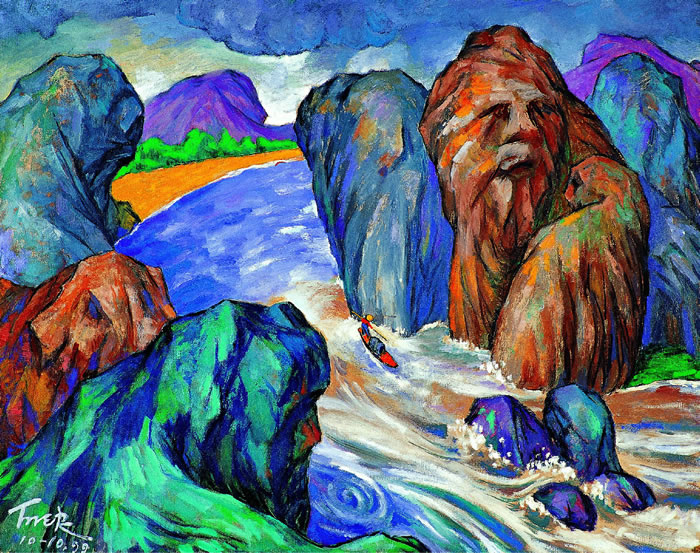
1999人生92x73cm
The significance of the Second Generation of the National Art College was in fact a ‘late’ discovery. The initial trigger started in local modern art history of the 1980s with the recognition of Chinese artists who were based overseas such as Zao Wou-ki and Chu Teh-Chun. Subsequently, many other artists came to be recognized as prominent artistic figures such as Lin Fengmian, Wu Dayu, and Fang Ganmin. Gradually other long forgotten artists, amongst whom Wu Guanzhong, Min Xiwen, Zhang Gongyi, Ding Tianque and many other disciples, were also rediscovered. In the process of restoration and cognition, we can’t help but admire their tenacity in preserving their artistic will in the tribulations of life, and admire the cutting-edge experimental characteristics of their artistic language in dialogue with the world. Amongst these major figures of Chinese 20th century art, Ding Tianque plays a special role. No matter how many trials and tribulations history witnesses, as long as there is a so-called mentality of “same aspirations, no separation”, there will be a pattern of height and light, and there will be a future for regeneration and bonding.

国画观音眺
Ding Tianque’s artistic life is ‘legendary’, intertwined with tears and moments of hope. His life also symbolizes the ‘brilliance’ of modern Chinese art that experienced self-improvement. It was also a long-lasting life. Together with his classmates from the Second Generation, Ding formed a community of shared destiny. Now that they are all prominent masters in art history research, why did they all enter the ‘list of prizewinners’ in historical research?

1990听蝉61x50cm
As a scholar specializing in the Second Generation, I had the opportunity to interact with some of its senior members over the past 30 years. In the early 90s, I visited Mr. Min Xiwen in order to write about the ‘History of Shanghai Oil Painting’. In 1996, I spoke at an academic seminar held by Mr. Wu Dayu in Beijing. Wu Guanzhong, Zhang Gongyi and other members of the Second Generation attended the seminar. They came for the First Generation of Wu Dayu, but their words about their Second Generation were touching. Four years ago, I also had the privilege of meeting personally Mr. Zhang Gongyi, the oldest witness of the Second Generation. If Wu Dayu is a ‘star’ that cannot be forgotten, then the relevant teachers and students who have learnt from his teaching have been synthesized into a unique ‘star’. Three years ago, I completed my first draft about the Second Generation of the ‘Invisible’ National Art College.
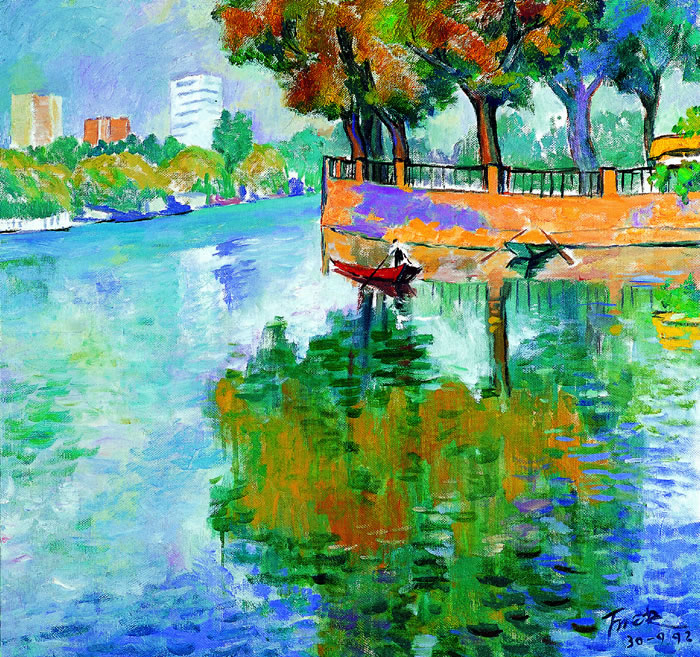
1992什刹海61x50cm
The draft was revised based on the support and encouragement of Ding Yunqiu and her circle of friends. Among the more than 300 family members of famous Chinese oil painters I have come into contact with, many have special humanistic feelings, and Ding Tianque’s dynamic and respectable niece, Ms. Ding Yunqiu, is one of them. Through her remarkable efforts, coupled with the concerted endeavours of her circle of friends, 2021 marked Ding Tianque’s ‘awakening’ time. On March 13 2021, a retrospective exhibition of Ding Tianque opened in Beijing, which was not only the first exhibition of ICI-LABAS Gallery in 2021, but also an important event in Beijing after the publication of Lonely Mountain in Dreams - Ding Tianque’s Artistic Life by China Academy of Art Press at the end of 2018. In October 2021, the opening ceremony and academic gathering around Ding Tianque’s Poetry Collection was held at the former site of Hangzhou National Art College, Xiling Calligraphy and Painting Institute. At the end of 2021 ICI-LABAS Gallery put together an exhibition of Ding Tianque’s poetry and painting. This was the second time that the Ding Tianque Poetry Collection went on show. Through the display of Mr. Ding Tianque’s manuscripts of poetry, original paintings and prints, the audience could witness his vivid creativity.

2006闲庭寂寞露华浓 80×60
After overcoming the difficult period of the epidemic, my team and I visited Ding Yunqiu in Beijing in June 2023. During our visit, Ding Yunqiu presented to us a book about Tianque Ding that her family and herself compiled and translated. This book represents an important academic milestone for Ding Tianque’s work. Together with her friends Ding Yunqiu is currently preparing an art tour exhibition of Ding Tianque. 2023 will mark an important year for Ding Tianque’s ‘rejuvenation’.
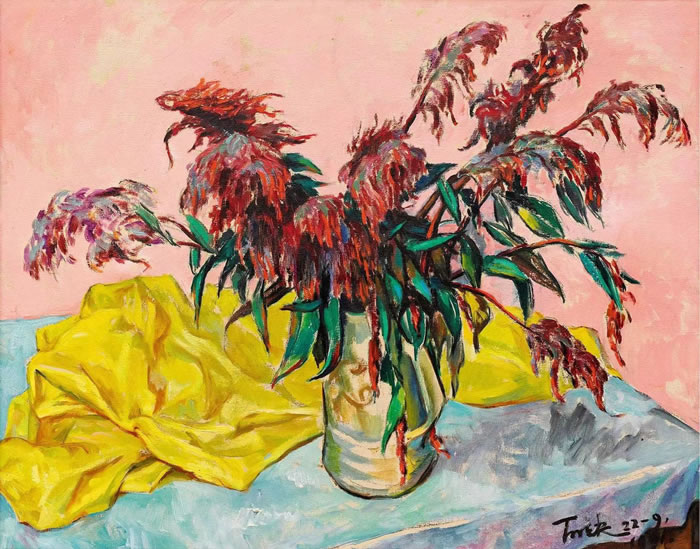
鸡冠花 81x64cm
The manuscripts of Lonely Mountain in Dreams, Ding Tianque’s Poetry Collection and Trivia on Pictorial Matters represent an important academic heritage left by Mister Ding for future research. They symbolize precious artistic and historical objects offered to the world by this artistic sage, which can be regarded as mature academic expressions of the Second Generation of the National Art College. Today, while the Second Generation is gradually moving away from the Kingdom of Heaven, many wonderful words and concepts condense their artistic creations and thoughts, and turn them into gratifying echoes of history. Between ancient and modern, between China and the West, as a result of the interculturalisation of art, Ding’s notes present us with his broad vision and deep thinking – evidencing again the artistic philosophy of the sages from the Second Generation.
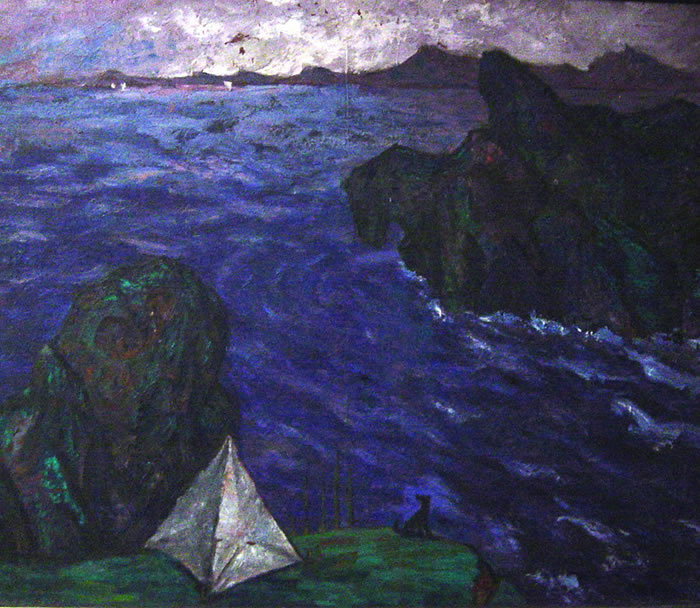
1980观音跳夕照80x70cm
It is worth noting that, although the art of the Second Generation has developed in different directions, the roots and influences of the academic school constitute common echoes in their artistic creations. These include the generalization of the structure of time and space, the lyricism of the spiritual world, and the writing of Chinese imagery. However, among the artists from the Second Generation, each of them shaped and explored their own stylized artistic path. From the images that we have left of Ding Tianque’s works from the 1940s, but also his art spanning the 1980s and 1990s, the sensitivity and creation of formal expression were always present in his artistic practice. The still-lives, portraits and landscapes that Ding provide a variety of signs of exploration, variation and reconstruction. The related artistic creations reflect the intercommunication and coordination of traditional integrity and language innovation in terms of spatial composition, color expression and image meaning-making. Once again, this evidences the dialectical understanding and penetration of the ‘new’ into artistic creation, extracting novel elements of innovative exploration from the depths of tradition, highlighting the ‘Chinese tense’ of modern art in the context of international dialogue, thus endowing Ding Tianque’s artistic and academic character. His painting style is innovative and unique, and his personality frank and original, which complements well the creativity of the Second Generation. With these, Ding became a vivid epitome of the era of modern Chinese painting in the 20th century.
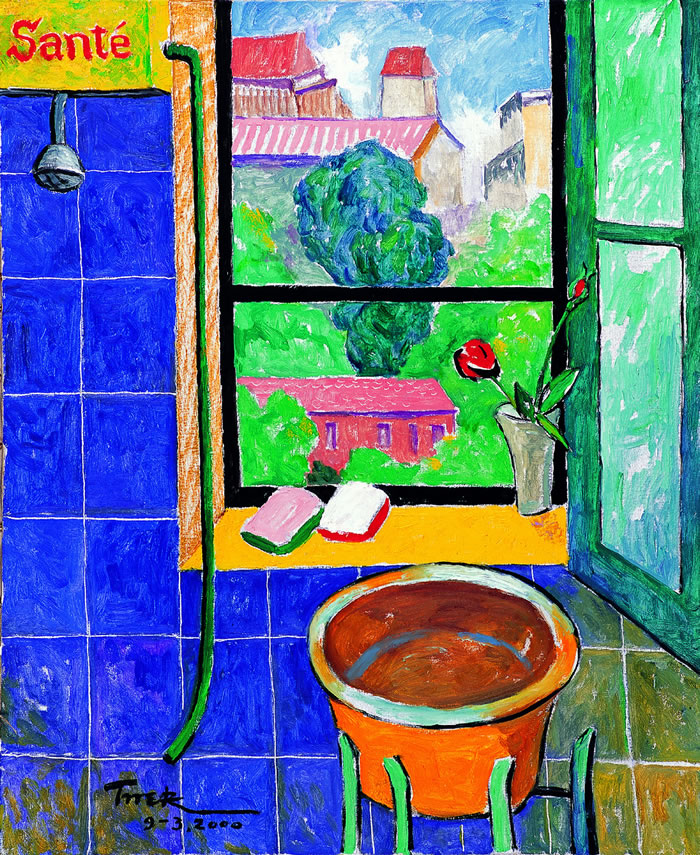
2000盥洗室85x60cm
Cultural inheritance is like a life bond, implicating the artistic journey of two generations of artists who ‘fought for art’. The value and significance of the research on these two generations of artists are not limited to the scope of history research on specific schools, but they have gradually moved into research on the history of modern Chinese art, and even the special field of international exchanges about modern art. The Ding Tianque Retrospective Exhibition of 2023 is undoubtedly contributing to move such academic interests forward. This academic positioning endows Ding Tianque with symbiosis and compatibility with Second Generation art resources, and constructs a narrative that starts from China and tells Chinese stories globally.

1992皆大欢喜92x73cm
Cooperating with the exhibition planning team, we realized that a shining point drives the line of brilliance. The sages of the Second Generation of the National Art College now represent an important research object in art history, and the combination of related historical and artistic objects is an important key to continuous and in-depth research. Here, the First and Second Generations have the residual situation of being obscured and fragmented; the existence of relevant artistic heritage can be limited; the bibliographic rate of relevant art documents is heavy or rare. We are also enthusiastic about reflecting on the role of academic empowerment of the achievements of modern art research through our own academic and database collections. It can be seen that the tour of this retrospective exhibition will be a vivid example of academic cooperation, interaction and social aesthetic education. From the 1980s to the present, artists from the National Art College have gradually emerged, forming an indispensable and important art group in research on modern Chinese art history. Almost every vibrant individual showcases precious cultural resources of this artistic group. Today, the Ding Tianque Retrospective Exhibition once again shines the academic light it deserves.

《虎跳峡》1980-85x64cm
Praise for Tianque Ding – the original intention of the Second Generation was to ‘leave nothing’. The ‘regeneration’ of Ding Tianque’s artistic resources definitely contributes to optimizing the academic ecology of modern Chinese art history research.
Senjodo, July 2023




